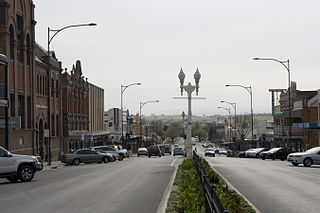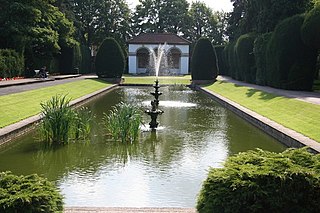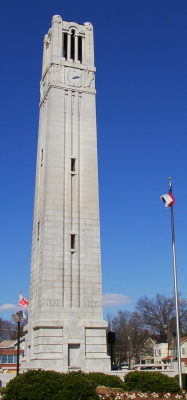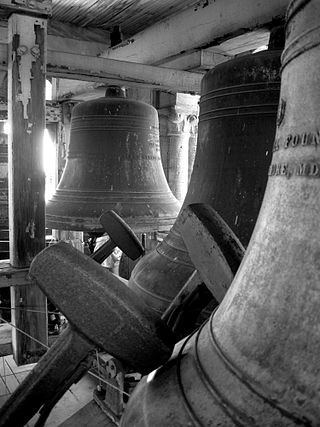Related Research Articles

A carillon ( KERR-ə-lon, kə-RIL-yən) is a pitched percussion instrument that is played with a keyboard and consists of at least 23 bells. The bells are cast in bronze, hung in fixed suspension, and tuned in chromatic order so that they can be sounded harmoniously together. They are struck with clappers connected to a keyboard of wooden batons played with the hands and pedals played with the feet. Often housed in bell towers, carillons are usually owned by churches, universities, or municipalities. They can include an automatic system through which the time is announced and simple tunes are played throughout the day.

The Netherlands Carillon is a 127-foot (39-m) tall campanile housing a 53-bell carillon located in Arlington County, Virginia. The instrument and tower were given in the 1950s "From the People of the Netherlands to the People of the United States of America" to thank the United States for its contributions to the liberation of the Netherlands in 1945 and for its economic aid in the years after. The Netherlands Carillon is a historic property listed on the National Register of Historic Places as part of Arlington Ridge Park, which is part of the George Washington Memorial Parkway. It is owned and operated by the National Park Service.

Bathurst is a city in the Central Tablelands of New South Wales, Australia. Bathurst is about 200 kilometres (120 mi) west-northwest of Sydney and is the seat of the Bathurst Regional Council. Bathurst is the oldest inland settlement in Australia and had a population of 37,191 in June 2019.

An eternal flame is a flame, lamp or torch that burns for an indefinite time. Most eternal flames are ignited and tended intentionally, but some are natural phenomena caused by natural gas leaks, peat fires and coal seam fires, all of which can be initially ignited by lightning, piezoelectricity or human activity, some of which have burned for hundreds or thousands of years.

Cootamundra, nicknamed Coota, is a town in the South West Slopes region of New South Wales, Australia and within the Riverina. It is within the Cootamundra-Gundagai Regional Council. At the 2016 Census, Cootamundra had a population of 6,782. It is located on the Olympic Highway at the point where it crosses the Muttama Creek, between Junee and Cowra. Its railway station is on the Main Southern line, part of the Melbourne-to-Sydney line.
The Australian–American Memorial is in Canberra, the national capital of Australia, and commemorates the help given by the United States during the Pacific War.

Soldiers' Tower is a bell and clock tower at the University of Toronto that commemorates members of the university who served in the World Wars. Designed by architects Henry Sproatt and Ernest Ross Rolph, the Gothic Revival tower stands at 143 feet tall and houses a carillon of 51 bells.

The Meneely Bell Foundry was a bell foundry established in 1826 in West Troy, New York, by Andrew Meneely. Two of Andrew's sons continued to operate the foundry after his death, while a third son, Clinton H. Meneely, opened a second foundry across the river with George H. Kimberly in Troy, New York in 1870. Initially named the Meneely Bell Company of Troy, this second foundry was reorganized in 1880 as the Clinton H. Meneely Company, then again as the Meneely Bell Company. Together, the two foundries produced about 65,000 bells before they closed in 1952.

The National War Memorial of New Zealand is located next to the Dominion Museum building on Buckle Street, in Wellington, the nation's capital. The war memorial was dedicated in 1932 on Anzac Day in commemoration of the First World War. It also officially remembers the New Zealanders who gave their lives in the South African War, World War II and the wars in Korea, Malaysia and Vietnam.

The Vytautas the Great War Museum is a museum in Kaunas, Lithuania. It was built in Art Deco and early functionalism style.

Bathurst Airport is an airport serving Bathurst, New South Wales, Australia.

The Eternal Light Peace Memorial is a 1938 Gettysburg Battlefield monument dedicated on July 3, 1938, commemorating the 1913 Gettysburg reunion for the 50th anniversary of the 1863 Battle of Gettysburg on July 3, 1913. The natural gas flame in a one-ton bronze urn is atop a tower on a stone pedestrian terrace with views from the terraced hill summit over about 400 sq mi (1,000 km2), and the flame is visible from 20 mi (32 km) away.

The Thomas Rees Memorial Carillon is a carillon located in Washington Park in Springfield, Illinois. The brutalist tower stands 132 feet and is constructed from concrete, brick and steel. It was dedicated in 1962 and designed by Bill Turley. Each year the carillon hosts the International Carillon Festival which features world-renowned carillonneurs.

Spalding War Memorial is a First World War memorial in the gardens of Ayscoughfee Hall in Spalding, Lincolnshire, in eastern England. It was designed by the architect Sir Edwin Lutyens. The proposal for a memorial to Spalding's war dead originated in January 1918 with Barbara McLaren, whose husband and the town's Member of Parliament, Francis McLaren, was killed in a flying accident during the war. She engaged Lutyens via a family connection and the architect produced a plan for a grand memorial cloister surrounding a circular pond, in the middle of which would be a cross. The memorial was to be built in the formal gardens of Ayscoughfee Hall, which was owned by the local district council. When McLaren approached the council with her proposal, it generated considerable debate within the community and several alternative schemes were suggested. After a public meeting and a vote in 1919, a reduced-scale version of McLaren's proposal emerged as the preferred option, in conjunction with a clock on the town's corn exchange building.

The University of Reading War Memorial is a clock tower, designed by Herbert Maryon and situated on the London Road Campus of the University of Reading. Initially designed as a First World War memorial and dedicated in June 1924, it was later expanded in scope to also serve as a memorial of later wars.

The North Carolina State University Memorial Belltower is a 115-foot-tall (35 m) free-standing bell tower on the Main Campus of North Carolina State University in Raleigh, North Carolina Conceived as a war memorial to honor university alumni killed in World War I and the university's overall participation in the conflict, the Belltower now serves as a perpetual memorial for N.C. State students and alumni who gave their lives in the service of the nation. A prominent university symbol, the tower is a popular rallying point for the campus community.

The Senior Memorial Chime, known more commonly as the Altgeld Chimes, is a 15-bell chime in Altgeld Hall Tower on the central campus of the University of Illinois Urbana-Champaign, in Urbana, Illinois, United States.
References
- 1 2 webadmin (11 April 2012). "Bathurst War Memorial Carillon". www.warmemorialsregister.nsw.gov.au. Retrieved 5 August 2020.
- ↑ Watson, Matt (1 April 2019). "Big reveal is close now for Eternal Flame's replacement". Western Advocate. Retrieved 6 August 2020.
- ↑ "TO COST £15,000 – Bathurst's War Memorial: Carillon of 23 Bells Proposed". National Advocate (Bathurst, NSW : 1889 - 1954). 25 August 1926. p. 2. Retrieved 5 August 2020.
- ↑ "BATHURST WAR MEMORIAL - OFFICIALLY UNVEILED BATHURST, Sunday. - Daily Advertiser (Wagga Wagga, NSW : 1911 - 1954) - 13 Nov 1933". Trove. Retrieved 5 August 2020.